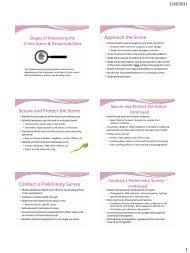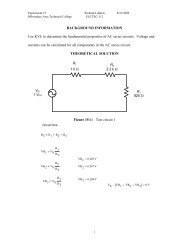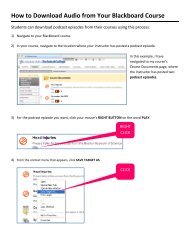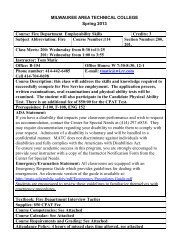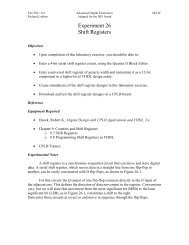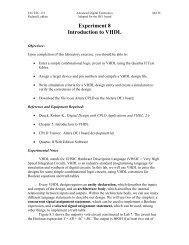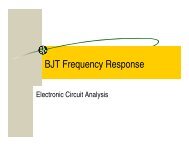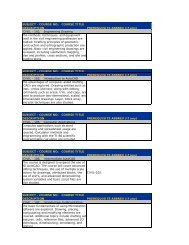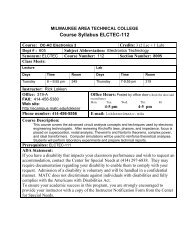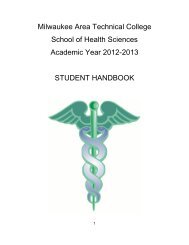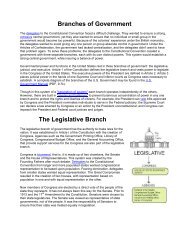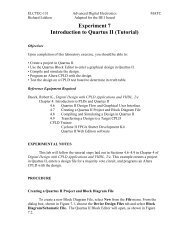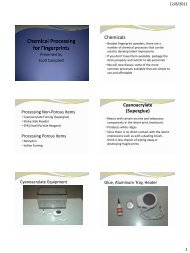WI Forward Award 2012 - Welcome to MATC - Milwaukee Area ...
WI Forward Award 2012 - Welcome to MATC - Milwaukee Area ...
WI Forward Award 2012 - Welcome to MATC - Milwaukee Area ...
You also want an ePaper? Increase the reach of your titles
YUMPU automatically turns print PDFs into web optimized ePapers that Google loves.
Strategic Planning: Category 2<br />
with oversight by the SPBSC. The SPBSC is made up of the<br />
co-chairs — one faculty and one administra<strong>to</strong>r — from each<br />
Core Committee: Curriculum and Learning Assessment<br />
(CLA); Student Success (SS); Academic Technology (AT);<br />
Strategic Enrollment Management (SEM); Collaborations and<br />
Partnerships (CP); Human Resources (HR), and Sustainability<br />
and Facilities (SF). The purpose of the SPBSC is <strong>to</strong> integrate<br />
facilitation, communication, and alignment of the planning<br />
and budgeting process with the committee co-chairs. The<br />
SPBSC moni<strong>to</strong>rs monthly progress and implements plans for<br />
increasing awareness of the process. Key <strong>to</strong> such facilitation<br />
and integration are college leaders responsible for institutional<br />
research, strategic planning, continuous improvements, and<br />
accreditation at the college. The college and faculty union<br />
presidents are invited <strong>to</strong> attend SPBSC meetings as well since<br />
recommendations from the core committees are sent <strong>to</strong> them<br />
for approval. The Strategic Plan, core committee reports, and<br />
divisional reports ensure communication input and outflow<br />
throughout the college. Our 2011-12 Strategic Plan can be found<br />
in Figure 2-1c.<br />
The annual strategic planning process allows for constant<br />
evaluation of external and internal fac<strong>to</strong>rs influencing the college<br />
<strong>to</strong> build upon our advantages and focus on our challenges. These<br />
challenges and advantages are identified through Conversation<br />
Days, internal reporting mechanisms, internal and external<br />
research studies, regular federal and state audits, the selfevaluation<br />
for HLC accreditation, and analysis of a number<br />
of outside evaluative reports, including the HLC Systems<br />
Appraisal, <strong>WI</strong> Fast <strong>Forward</strong> Feedback, Titus Report, and the<br />
HLC Quality Check-up Report, as well as posted Environmental<br />
Scan information and dashboards (KPIs) from IRSP. Based on<br />
new input each spring, the direc<strong>to</strong>r of IRSP, along with our AQIP<br />
Liaison, readjust the Strategic Plan relative <strong>to</strong> its seven-year goals<br />
and objectives, adding new strategies/tactics /projects addressing<br />
newly-identified institutional. While the current plan spans a<br />
seven-year period and the goals remain, objectives, strategies and<br />
tactics, continuous improvement action projects, and measures<br />
are annually reviewed and changed or continued for purposes of<br />
relevancy and progress.<br />
Each vice president is an operational champion for the annual<br />
strategic plan within their division or scope of responsibility, and<br />
each leader utilizes the strategic planning goals and objectives<br />
<strong>to</strong> set more specific annual strategies for their departments and<br />
divisions. They oversee action plans related <strong>to</strong> the overall college<br />
plan, often by co-chairing a core committee. Champions are<br />
also key support for the planning process as they help remove<br />
barriers encountered by core committees or their strategy work<br />
teams, communicate with other champions as an advocate for<br />
the actions or directions approved by the champions as a whole,<br />
ensure process alignment within and among departments,<br />
participate in the annual review of strategies, tactics, and action<br />
projects, and identify and approve resources needed <strong>to</strong> improve<br />
key areas through implementation of planning recommendations.<br />
Potential blind spots are identified during the planning process<br />
based on information gleaned from the communication <strong>to</strong>ols<br />
discussed in 1.1b and shown in Figure 1-1c, and the various<br />
regula<strong>to</strong>ry authorities featured in Figure P-1b. Climate data<br />
collected on college performance is posted as dashboards for<br />
the college leadership and community on the college website.<br />
IRSP staff conducts over 200 analyses annually <strong>to</strong> ensure <strong>to</strong>pical<br />
awareness of key issues and developments throughout the year.<br />
They also sit on core committees as non-voting data resources.<br />
In the planning process, strategies are usually identified as shor<strong>to</strong>r<br />
long-term. Most action projects are annual <strong>to</strong> fit in with the<br />
faculty’s academic calendar with benchmarks and deadlines set<br />
throughout the year as stated on their Action Project Charters.<br />
Specific planning timelines differ among work teams based on<br />
their objectives. “Roll over” projects are those that need <strong>to</strong> be<br />
broken in<strong>to</strong> phases of planning and implementation over multiple<br />
years. Timelines for 2011-12 projects are identified on Figure 2-1c.<br />
2.1.a(2) Strategy Considerations<br />
Since 2009, IRSP has worked <strong>to</strong> ensure that the Strategic Plan<br />
focuses on achieving <strong>MATC</strong>’s vision <strong>to</strong> “enrich, empower, and<br />
transform” lives in the community and our mission “<strong>to</strong> offer<br />
quality educational and training opportunities and services <strong>to</strong><br />
its diverse, metropolitan community.” As a result, the Strategic<br />
Plan shows the path <strong>to</strong> accomplishing the mission and moving<br />
<strong>to</strong>ward the vision by clearly connecting planning goals using<br />
research data throughout the process and ensuring collaboration<br />
of and obtaining input from key college stakeholders.<br />
The Strategic Plan addresses major shifts in technology,<br />
educational programs and services, community demographics,<br />
competition, and the economy while maintaining a vision for<br />
long-term sustainability. IRSP achieves this by reviewing trends<br />
in the local district, metro, and state; national economic and<br />
work force trends and projections; state technical college system<br />
mandates; technical college program developments, and local geodemographic<br />
changes. Primary data on educational competition<br />
are collected on six-year cycles through a market-focused<br />
community perception study. Annual competitive developments<br />
are included in SWOT analyses, where available. Measures<br />
common <strong>to</strong> peer two-year colleges on institutional and student<br />
performance are used annually <strong>to</strong> assess relative performance.<br />
The mission, vision, and values are also embodied in the work<br />
of the core committees and their strategy work teams. This<br />
ensures long-term institutional viability by focusing on our core<br />
competency of education while engaging more stakeholders in<br />
ownership of improvement processes.<br />
As shown in Figure 2-1c, many indica<strong>to</strong>rs involving college<br />
programs, services, technical innovations, community<br />
partnerships, sustainability interventions, student demographics,<br />
and success initiatives are found on the annual Strategic Plan.<br />
2.1.b STRATEGIC OBJECTIVES<br />
2.1.b(1)(2) Key Strategic Objectives & Considerations<br />
Strategic Planning goals are linked <strong>to</strong> the appropriate core<br />
committee(s), with each assigned an administrative champion<br />
from the President’s Executive Cabinet and serving as the key<br />
advocate for implementation. In turn, each goal has a set of<br />
more concrete objectives, with associated strategies, tactics and<br />
action projects of even greater specificity. <strong>MATC</strong>’s key strategic<br />
objectives help reach the five strategic goals (Figure 2-1c).<br />
These objectives align with the values of the institution, address<br />
strategic challenges, and build on strategic advantages.<br />
7



